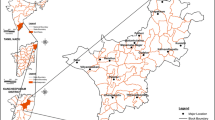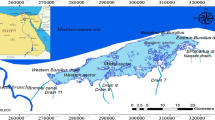Abstract
Can, a county in the province of Canakkale, is one of the most prominent coal mining districts in Turkey. Many mining companies have been operating coal deposits for power generation and district heating in this region since 1980. Generally, small and medium-scale mining companies operate for short periods and abandon the operational land without providing any rehabilitation. Human intervention in the natural structure and topography of the earth surface causes large holes and deterioration in these areas. Artificial lakes occur because of surface discharge and underground leakage into abandoned open pit mines with high lignite sulfur content (0.21–14.36 wt %). Furthermore, these lakes gain acidic character due to acid generation from pyrite oxidation. Acid mine lakes are highly acidic (pH < 3.05) and have elevated concentrations of \({\text{SO}}_{4}^{2 - }\), Fe and some metals. The main objective of this study is to evaluate the environmental conditions and demonstrate the development of a monitoring system for their possible changes in the acid mine lakes of the open cast lignite mining area on a regional scale. For this purpose, the data received from remote sensing satellites were used. Areal change detection and perimeter changes of nine acid mine lakes caused by coal mining companies in Can from 1977 to 2011, were determined using Landsat, Quickbird and Worldview satellite images. As a case study, an area of 9 km2 was chosen for the variety of acid mine lakes. Using GIS software, satellite images were analyzed in time series, borders of acid mine lakes were digitized and converted into vector data format. At this stage, prior to the digitization, in order to create contrast on the satellite images, “stretch type” and “stretch values” were changed. The areal and perimeter changes were computed and presented via tables and graphics. In addition, thematic maps of the acid mine lakes were created and visualized. The results show that the number of acid mine lakes increased and these caused environmental risks due to their hydrochemical properties and areal increments.













Similar content being viewed by others
References
Akcil A, Koldas S (2006) Acid mine drainage (AMD): causes, treatment and case studies. J Clean Prod 14:1139–1145
Anderson MC, Norman JM, Mecikalski JR, Torn RD, Kustas WP, Basara JB (2004) A multi-scale remote sensing model for disaggregating regional fluxes to micrometeorological scales. J Hydrometeor 5:343–363
Baba A, Gunduz O (2010) Effect of alteration zones on water quality: a case study from Biga Peninsula, Turkey. Arch Environ Contam Toxicol 58(3):499–513
Baba A, Save D, Gunduz O, Gurdal G, Bozcu M, Sulun S, Ozcan H, Hayran O, Ikiisik H, Bakirci L (2009) The assessment of the mining activities in Can Coal Basin from a medical geology perspective. Final report, The Scientific and Technological Research Council of Turkey (TUBITAK), Project No: CAYDAG-106Y041, Ankara (in Turkish)
Bell FG, Bullock SET, Halbich TFJ, Lindsay P (2001) Environmental impacts associated with an abandoned mine in the Witbank Coalfire, South Africa. Int J Coal Geol 45:195–216
Bhattacharya A, Routh J, Jacks G, Bhattacharya P, Morth M (2006) Environmental assessment of abandoned mine tailings in Adak, Vasterbotten district (northern Sweden). Appl Geochem 21:1760–1780
Bigham JM, Nordstrom DK (2000) Iron and aluminum hydroxysulfates from acid sulfate water. In: Alpers CN, Jambor JL, Nordstrom DK (eds) Review in mineralogy and geochemistry : sulfate minerals: crystallography, geochemistry, and environmental significance, 40th edn. The Mineralogical Society of America, Washington, pp 351–403
Bigham JM, Carlson L, Murad E (1994) Schwertmannite, a new iron oxyhydroxysulfate from Pyhäsalmi, Finland, and other localities. Mineral Mag 58:641–648
Bozcu M, Akgun F, Gurdal G, Yesilyurt SK, Karaca O (2008) Sedimentologic, petrologic, geochemical and palinologic examination of Can Yenice Bayramic (Canakkale) lignite basin. Final Report of the Scientific and Technological Research Council of Turkey (TUBITAK), Project No: CAYDAG-105Y114, Ankara (in Turkish)
Cravotta AC (2008) Dissolved metals and associated constituents in abandoned coal-mine discharges, Pennsylvania, USA. Part 1: constituent quantities and correlations. Appl Geochem 23:166–202
Environmental Protection Agency (2003) National primary drinking water standards. Office of Water, United States Environmental Protection, EPA 816-F-03-016
Equeenuddin SM, Tripathy S, Sahoo PK, Panigrahi MK (2010) Hydrogeochemical characteristics of acid mine drainage and water pollution at Makum Coalfield, India. J Geochem Explor 105:75–82
Ercan T, Satir M, Steinitz G, Dora A, Sarifakioglu E, Adis C, Walter HJ, Yildirim T (1995) Characteristics of the tertiary volcanism in the Biga Peninsula, Gokceada, Bozcaada and Tavsanadasi, NW Anatolia. MTA Bull 117:55–86 (in Turkish)
Gurdal G (2011) Abundances and modes of occurrence of trace elements in the Can coals (Miocene), Canakkale-Turkey. Int J Coal Geol 87:157–173
ITASHY (2005) Regulation on waters intended for human consumption. Official Gazette dated 17/02/2005, No:25730, Ankara (in Turkish)
Latifovic R, Fytas K, Chen J, Paraszczak J (2005) Assessing land cover change resulting from large surface mining development. Int J Appl Earth Obs 7:29–48
Latifovic R, Fytas K, Paraszczak J (2006) Satellite remote sensing as means to assess primary impact of open-pit mining. In: New technological solutions in underground mining: International Mining Forum 2006. Proceedings and monographs in engineering, water and earth sciences, Cracow, Poland, pp 161–171
Lee JS, Chon HT (2006) Hydrogeochemical characteristics of acid mine drainage in the vicinity of an abandoned mine, Daduk Creek, Korea. J Geochem Explor 88:37–40
Lee G, Bigham JM, Faure G (2002) Removal of trace metals by coprecipitation with Fe, Al and Mn from natural waters contaminated with acid mine drainage in the Ducktown Mining District, Tennessee. Appl Geochem 17:569–581
Mapper (TM) (2010). http://eros.usgs.gov/#/Find_Data/Products_and_Data_Available/TM
Mills C (1995) An AMD/ARD dedicated blog, based on the text of a presentation given Mills to British Columbia high school science teachers. In: A seminar on acid rock drainage at the cordilleran roundup, Vancouver
Monterroso C, Macias F (1998) Drainage waters affected by pyrite oxidation in a coal mine in Galicia, NW Spain: composition and mineral stability. Sci Total Environ 216:121–132
Nordstrom DK (1982) Aqueous pyrite oxidation and the consequent formation of secondary iron minerals. In: Kittrick JA, Fanning DS, Hossner LR (eds) Acid sulfate weathering. Soil Science Society of America Special Publication 10, Madison, pp 37–55
Nordstrom DK, Alpers CN, Ptacek CJ, Blowes DW (2000) Nagative pH and extremely acidic mine waters from Iron Mountain, California. Environ Sci Technol 34:254–258
Oh HJ, Lee S (2011) Integration of ground subsidence hazard maps of abandoned coal mines in Samcheok, Korea. Int J Coal Geol 86:58–72
Ozcelik GA (2007) Prediction techniques of acid mine drainage: A case study of a new poly- metallic mine development in Erzincan-Ilic, Turkey. PhD Thesis, The Graduate School of Natural and Applied Sciences of Middle East Technical University, pp 260
Ozesmi S, Bauer M (2002) Satellite remote sensing of wetlands. Wetlands Ecol Manag 10:381–402
Paktunc AD (1999) Characterization of mine wastes for prediction of acid mine drainage. In: Azcue JM (ed) Environmental impacts of mining activities. Springer, Berlin, pp 19–39
Paterson N (1997) Remote mapping of mine wastes. In: Gubins AG (ed.) Mapping and monitoring the mine environment. In: Proceedings of exploration 97: fourth decennial international conference on mineral exploration, pp 905–916
Peichang S, Cheng S, Smith S (2004) Acid lake identification using GIS and remote sensing. In: Geological Society of America, Denver annual meeting, November 7–10
Ribeiro J, Ferreira da Silva E, Li Z, Ward C, Flores D (2010) Petrographic, mineralogical and geochemical characterization of the Serrinha coal waste pile (Douro Coalfield, Portugal) and the potencial environmental impacts on soil, sediments and sufarce waters. Int J Coal Geol 83:456–466
Robitaille R, Dempsey D, Galli A (1991) The use of landsat TM imagery in the detection of mine sites and mine wastes in the Sudbury, Ontario region. In: Proceedings eight thematic conference on geologic remote sensing, pp 955–958
Sabins FF (1999) Remote sensing for mineral exploration. Ore Geol Rev 14:157–183
Sanliyuksel D, Baba A (2011) Effects of the abandoned mining wastes on water resources in Can Basin. In: 64th geological congress of Turkey, Ankara, pp 47–48
Sanliyuksel Yucel D (2013) Characteristics of acidic water resources, factors enabling their formation and hydrogeochemical properties (Can-Bayramic; Biga Peninsula). Doctoral Dissertation in Geology Engineering, Graduate School of Natural and Applied Sciences, Canakkale Onsekiz Mart University (in Turkish)
Sanliyuksel Yucel D, Baba A (2013a) Geochemical characterization of acid mine lakes and their effect on the environment, NW of Turkey. Arch Environ Contam Toxicol 64:357–376
Sanlıyuksel Yucel D, Baba A (2013b) Effects of acid mine lakes on water resources in Biga Peninsula, Turkey. In: The second international conferance on water, energy and the environment (ICWEE’2013). Kusadasi, Turkey, Paper number 277, pp 1–10
Sanliyuksel Yucel D, Sengun F, Baba A (2012) Effects of alteration zones on water resources in Can Basin. In: 65th geological congress of Turkey, Ankara, pp 122–123
Sanliyuksel Yucel D, Baba A, Sengun F, Yücel MA (2013) Drainage waters affected by pyrite oxidation in an open pit coal mine in Can Region, NW Turkey. In: IAH 2013 Congress, Perth, Australia, paper number 32, pp 65
Schroeter L, Glasser C (2011) Analyses and monitoring of lignite mining lakes in Eastern Germany with spectral signatures of Landsat TM satellite data. Int J Coal Geol 86:27–39
Si H, Bi H, Li X, Yang C (2010) Environmental evaluation for sustainable development of coal mining in Qijiang, Western China. Int J Coal Geol 81:163–168
Siyako M, Burkan KA, Okay AI (1989) Tertiary geology and hydrocarbon potential of the Biga and Gelibolu Peninsulas. Turk Petrol Geologists Assoc Bull 1(3):183–200 (in Turkish)
Spahn JL (1983) A land cover classification of a portion of the Western Kentucky coal field utilizing multi-temporal thematic mapper simulator data. In: ACSM-ASP Fall convention proceedings, pp 367–377
SRK (2012) Preliminary economic assessment technical report for the Halilağa Project, Turkey. Report Prepared for Truva Bakır Maden İşletmeleri Inc. and Pilot Gold Inc. Report Prepared by SRK Consulting (Canada) Inc., Ankara. pp 249
Thematic Mapper Plus (ETM+) (2012). http://eros.usgs.gov/#/Find_Data/Products_and_Data_Available/ETM
USEPA (1994a) Innovative methods of managing environmental releases at mine sites. US Environmental Protection Agency, Office of Solid Waste, Special Wastes Branch, Washington (OSW Doc. 530-R-94-012, April)
USEPA (1994b) Acid mine drainage prediction. US Environmental Protection Agency, Office of Solid Waste, Special Wastes Branch, Washington (EPA 530-R-94-036, December)
USGS (ed.) (2006a) Landsat Project. http://landsat.usgs.gov
USGS (ed.) (2006b) Earth resources observation and science (EROS). Landsat Enhanced
USGS (ed.) (2006c) Earth resources observation and science (EROS). Landsat Thematic
Woldai T (2001) Applications of remotely sensing data and GIS in assessing the impact of mining activities on the environment, in IMCET. In: Proceedings of the 17th international mining congress and exhibition of Turkey, pp 75–83
WHO (2004) World health organization guidelines for drinking water quality, vol 1, 3rd edn. WHO, Geneva
Yenilmez F, Kuter N, Emil MK, Aksoy A (2011) Evaluation of pollution levels at an abandoned coal mine site in Turkey with the aid of GIS. Int J Coal Geol 86:12–19
Yucel MA, Sanliyuksel Yucel D (2012) Determining and visualization of border changing on coal mining activities with satellite images and geographic information system (GIS) in Can (Canakkale) County, Canakkale Onsekiz Mart University Scientific Research Project, Project Number: BAP 2011/082, pp 40 (in Turkish)
Yucel MA, Sanlıyuksel Yucel D, Baba A (2013) Determining and monitoring of acid mine lakes using satellite ımages and geographic ınformation system (GIS) in Can County, NW Turkey. In: IAH 2013 Congress, Perth, Australia, Paper number 106, pp 195
Acknowledgments
This research is funded by the Canakkale Onsekiz Mart University, Scientific Research Project Number: 2011/082. The authors would like to thank Reviewers for constructive reviews of the manuscript.
Author information
Authors and Affiliations
Corresponding author
Rights and permissions
About this article
Cite this article
Yucel, D.S., Yucel, M.A. & Baba, A. Change detection and visualization of acid mine lakes using time series satellite image data in geographic information systems (GIS): Can (Canakkale) County, NW Turkey. Environ Earth Sci 72, 4311–4323 (2014). https://doi.org/10.1007/s12665-014-3330-6
Received:
Accepted:
Published:
Issue Date:
DOI: https://doi.org/10.1007/s12665-014-3330-6




